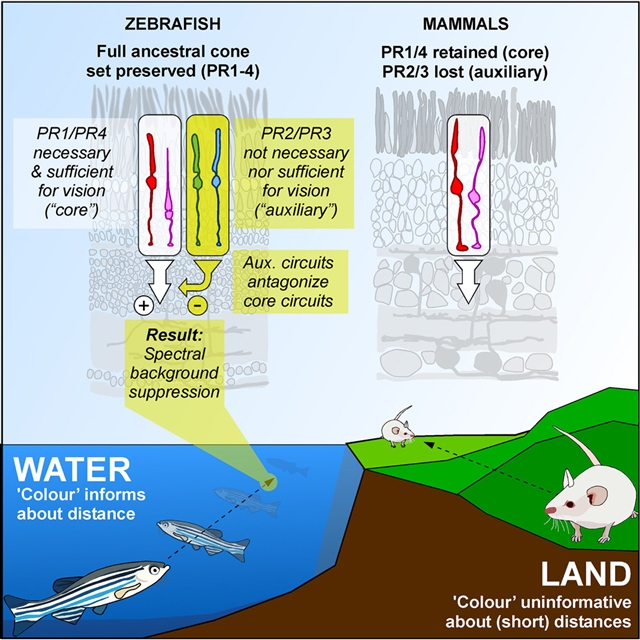
苏塞克斯大学Tom Baden团队的一项最新研究提出了斑马鱼利用光谱信息来抑制视觉背景。2025年11月3日,国际知名学术期刊《细胞》发表了这一成果。
课题组研究人员发现斑马鱼主题“颜色”信息抑制对视觉背景的反应。为此,斑马鱼将其完整的祖先锥体补体分为两个相反的系统:PR1/4(“红色/紫外线锥体”)和PR2/3(“绿色/蓝色锥体”)。其中,在哺乳动物中保留的消色差PR1和PR4是视觉所必需和充分的。相比之下,在哺乳动物中缺失的与颜色对立的PR2和PR3对于视觉来说既不是必要的,也不是充分的。相反,它们形成了一个“辅助”系统,在光谱上抑制来自PR1和PR4的“核心”驱动。他们的见解挑战了长期以来的观点,即脊椎动物的锥体多样性主要服务于色觉,并进一步暗示陆地化,而不是夜间化,是哺乳动物视觉回路重组的主要驱动力。
据悉,视觉最初是在水中进化的,光的光谱含量决定了观看距离。然而,水生视觉系统是否以及如何利用这一“物理事实”仍然未知。
附:英文原文
Title: Zebrafish use spectral information to suppress the visual background
Author: Chiara Fornetto, Thomas Euler, Tom Baden
Issue&Volume: 2025-11-03
Abstract: Vision first evolved in the water, where the spectral content of light informs about viewing distance. However, whether and how aquatic visual systems exploit this “fact of physics” remains unknown. Here, we show that zebrafish use “color” information to suppress responses to the visual background. For this, zebrafish divide their intact ancestral cone complement into two opposing systems: PR1/4 (“red/UV cones”) versus PR2/3 (“green/blue cones”). Of these, the achromatic PR1 and PR4, which are retained in mammals, are necessary and sufficient for vision. By contrast, the color-opponent PR2 and PR3, which are lost in mammals, are neither necessary nor sufficient for vision. Instead, they form an “auxiliary” system that spectrally suppresses the “core” drive from PR1 and PR4. Our insights challenge the long-held notion that vertebrate cone diversity primarily serves color vision and further hint at terrestrialization, not nocturnalization, as the leading driver for visual circuit reorganization in mammals.
DOI: 10.1016/j.cell.2025.10.009
Source: https://www.cell.com/cell/abstract/S0092-8674(25)01138-9
